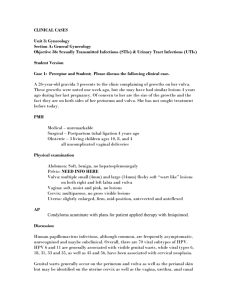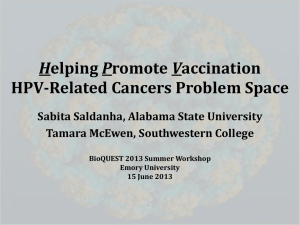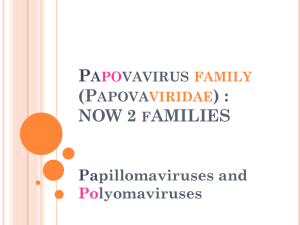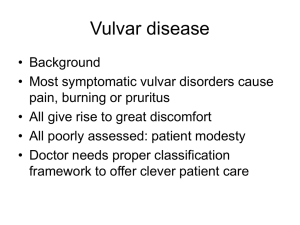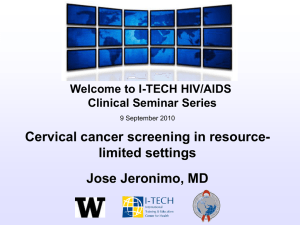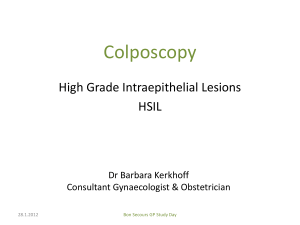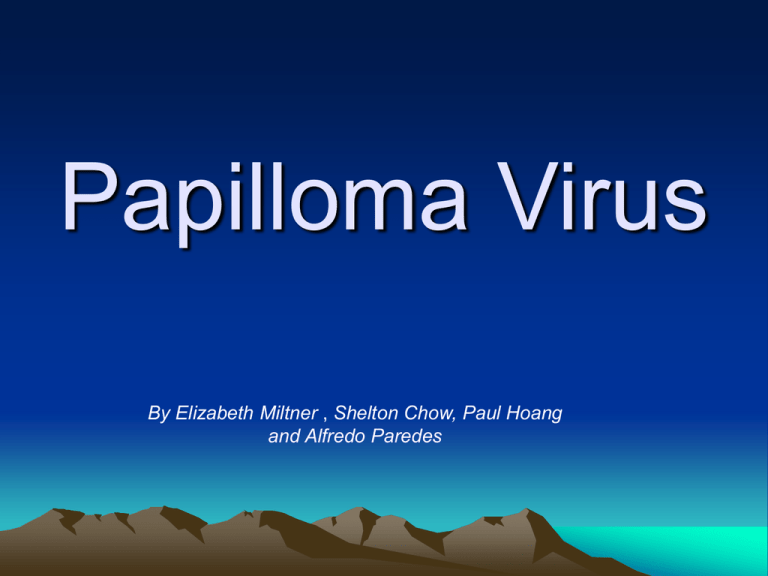
Papilloma Virus
By Elizabeth Miltner , Shelton Chow, Paul Hoang
and Alfredo Paredes
Pathogenesis
•
•
•
•
•
Double stranded DNA virus
Over 70 genotypes of HPV
Human reservoir and worldwide occurrence
Transmission via direct contact
Infects epithelial cells
– Junction of squamous and columnar epithelium
• Integrates into host genome in malignant lesions
• Contain “transforming genes” that play role in
malignant transformation.
• Associated with cancer of the cervix and anal
neoplasia
Clinical Presentation
Mucosal Lesions:
Appear as single or multiple areas of thickened epithelium
May have fine hairlike surface projections
May be flat and diffuse or raised and pedunculated
Whitish mainly but may be reddish or pinkish color just like
normal oral mucosa
May be found on soft and hard palate, lips, gingiva, buccal and
labial mucosa, or floor of mouth depending on type of HPV
Skin Lesions:
Lesions are similar in appearance to oral
lesions except that it is grayish brown in
color due to the dry environment
Common on genitals, hands and fingers
Genital Lesions:
Soft, moist, or flesh colored
Can occur in clusters (cauliflower like bumps)
Can be raised or flat, small or large
Dry, painless, firm and rough in texture
In men
Can occur on scrotum or penis, on the anus and within
the rectum
Can involve the urethra and bladder
In women:
Can occur on the vulva, cervix, vagina, and anus
Diagnostic Tests
• Can generally be diagnosed simply by
their location and appearance.
• Verruca Vulgaris (warts):
– Lesions are exophytic, keratinized, sessile
papules or nodules with cauliflower surfaces.
– Lesions usually measure 2 to 5 mm.
– Biopsy to confirm diagnosis. Koilocytes
indicate HPV infection.
Diagnostic Tests
• Condylomata acuminata (genital warts):
– Present as solitary or multiple, pinkish, sessile papules or
plaques with pebbled surfaces or as pedunculated papillary
lesions.
– In women, a pelvic examination may reveal growths on the
vaginal walls or the cervix.
– Colposcopy may be used to see lesions invisible to the naked
eye.
– The tissue of the vagina and cervix may be treated with acetic
acid to make the warts visible.
– A pap smear may note changes associated with HPV. If results
indicate abnormal changes that may be due to a high-risk type of
HPV, then DNA HPV testing may be ordered as a follow-up test.
Diagnostic Tests
• There are more than 100 types of HPVs.
• The HC2 High-Risk HPV DNA Test,
manufactured by Digene Corp., can identify 13
of the high-risk types associated with the
development of cervical cancer.
• The HPV DNA test does not test for cancer, but
for the HPV viruses that can cause cell changes
in the cervix. If left untreated, these changes can
eventually lead to cancer in some women.
Histological Appearance
of HPV
Human Papilloma Virus in Cervix
HPV infection characterized by cells with
pyknotic, irregular nuclei and clear
cytoplasm. Moderate squamous dysplasia
is also present.
HPV lesions exhibit extensive epithelial
hyperplasia with acantosis, fusion and
blunting of rete pegs
Normal tissue from
the cervix
A high-grade Squamous Intraepithelial
Lesion (HSIL)
Koilocytes (LSIL,600x)
HPVs are small, double-stranded DNA viruses, which infect stratified squamous or
endocervical glandular epithelium, where they stimulate epithelial proliferation with
unusual arrangement of nuclear material (mitosoid cells).
Microscopy view of normal cell on
a Pap test.
Treatment for
HPV
Treatment
• Goals: relieve symptoms and clearance of
visible warts
• Drug and/or Non-drug therapy
• Recurrence with both modalities is not
uncommon
Drug Therapy
• Anogenital warts:
– Patient applied:
• Podophyllotoxin, imiquimod
– Provider applied:
• podopyllin, 80-90% TCA
• Cutaneous Warts
– salicylic acid
Non-Drug Therapy
• Provide immediate removal of wart
• Safe during pregnancy
• Side effects may include: pain, ulcers and
blistering
• Surgical therapies:
– Cryotherapy
– Excsion
– Electrosurgery
– Laser surgery
HPV Vaccine
• Gardasil® approved in 2006 for use in women
• Protects against four HPV types (6,11,16, 18),
• These genotypes are responsible for 70% of cervical cancers
and 90% of genital warts.
• Current recommendations
– Should be administered before start of sexual activity
– In sexually active women vaccine will be effective if
no prior infection by the 4 genotypes
– Recommended for ages 11-26 years (but can be used
in girls as young as 9)
• Efficacy studies in men are underway
References
•
•
•
•
•
•
•
•
•
ASCCP: http://www.asccp.org/edu/practice/cervix/histology.shtml#
CDC 2006 STD Treatment Guidelines
Control of Commnicable Diseases manual. 18th Edition, 2004.
HPV and HPV Vaccine – Information for Healthcare Providers. CDC.
http://www.cdc.gov/std/hpv/STDFact-HPV-vaccine-hcp.htm
Pathology and Laboratory Medicine:
http://www.fahc.org/pathology/Education/hpv_powerpoints.html
Sapp JP, Eversole LR, Wysocki GP: Contemporary Oral and
Maxillofacial Pathology
Sherris Medical Microbiology. 4th Edition, 2004.
ACP PIER: The Physcian’s Information and Education Resource
2007.
University of Washington, Department of Pathology:
http://www.pathology.washington.edu/clinical/HPV/
Questions
• What is the reservoir for papilloma viruses that
infect humans?
a: livestock
b: dogs
c: humans
d: reptiles
• The HPV vaccine protects against:
a: genital warts
b: focal epithelial hyperplasia
c: cervical cancer
d: both A and C




